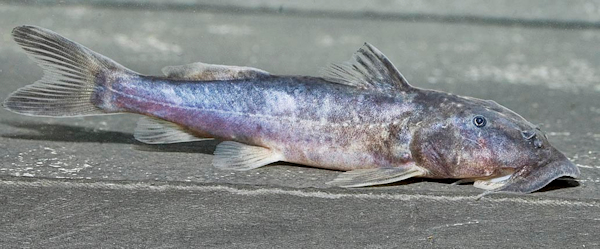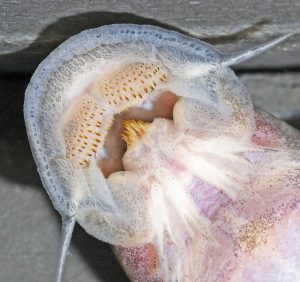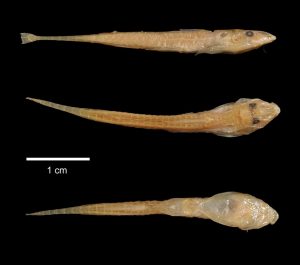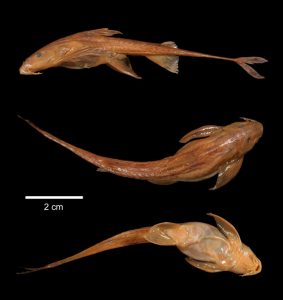Loricariidae live only in South America (apart from areas of invasive distribution – such as the southern states of the USA or Southeast Asia).
Most of the people know at least roughly how the geological development of the continents expired: Until about 200 million years ago, South America and Africa were part of the great continent of Gondwana.
The question about Loricariidae or their relatives in Africa is obvious.
Chiloglanis – the African suckling catfishes
Chiloglanis – also known as rapids catfishes – are very similar with their suction mouth. The sucking mouth is covered with papillae as in the Loricariidae. It is also used to hold on to wood, stones, plants etc.
W.Peter established the genus Chiloglanis in 1868: “Ueber eine von dem Baron Carl von der Decken entdeckte neue Gattung von Welsen, …“. The type species is Chiloglanis deckenii –named after the collector of the type material.
About 60 species are currently described in the genus Chiloglanis.
Chiloglanis live in rapids and fast flowing waters around the Nile and in West Africa. They grow up to approx. 10 cm. Chiloglanis eat plants and the microorganisms in the plants.
The genus Chiloglanis belongs to the family Mochokidae, which is exclusively native to Africa
Phylogenetically, the Mochokidae are related to the South American families Doradidae (Thorn catfishes) and Auchenipteridae (False Thorn catfishes). Look José L. O. Birindelli “Phylogenetic relationships of the South American Doradoidea (Ostariophysi: Siluriformes)“
Subfamily Doumeinae – look partly like Loricariinae (Whiptail catfisches)
Some of the catfish from subfamily Doumeinae are reminiscent of the South American Whiptail catfishes .
The following genera belong to this subfamily:
- Andersonia
- Belonoglanis (Eidechsenwelse)
- Congoglanis
- Doumea
- Phractura
- Trachyglanis
The name Doumeinae is derived from the genus Doumea.
The catfishes of the genus Doumea have bone tips. These are considered to be the precursors of bone plates.
Catfishes of the other genera mentioned above have bone plates, as we know them from the Loricariidae or Loricariinae.
The Doumeinae are subordinate to the family Amphiliidae, Regan, 1911 (African loach catfishes).
Sauvage created the genus Doumea in 1879. Look: “Notice sur la faune ichthyologique de l’Ogôoué“. Type species of the genus is Doumea typica.
These catfish have bone spikes.
Doumea live in the Dja River and the coastal waters of the Congo, Gabon, and Republic of Cameroon. They can reach a size of approx. 25 cm.
Belonoglanis
The genus Belonoglanis includes 2 genera from the tributaries of the Congo River. These catfishes are also known as lizard catfish. They are up to 20 cm tall.
The type species is Belonoglanis tenuis. Boulenger described this species in 1902: “Additions à la faune ichthyologique de bassin du Congo. Matériaux pour la faune du Congo“
Phractura
Catfish of the genus Phractura have a very long tail.
The type species is Phractura bovei. A. Perugia already described this species as Peltura bovei in 1892: Annali del Museo civico di storia naturale di Genova
The catfish of this genus are also called African Whiptailed catfish in English.
Bildquellen:
Cover picture: Chiloglanis sp. from the Congo River Haps – CC NY-SA 3.0
Pic. 1: Lenny222″, extract from: Laurasia-Gondwana.png, CC BY-3.0
Pic. 2: Haps – CC NY-SA 3.0
Pic. 3: W. Peters in “Ueber eine von dem Baron Carl von der Decken entdeckte neue Gattung von Welsen, …”
Pics. 4, 6: Georg Alber Boulenger, 1911 in “Catalog of the fresh-water fishes of Africa in the Britisch Museum“, Vol. 2
Pic. 5: Jon Armbruster – CC YN 2.0, Wikipedia
Pic. 7; A. Perugia, 1891 ” Annali del Museo civico di storia naturale di Genova”
Pics. 8, 9, 10: The Trustees of the Natural History Museum, London; CC BY-4.0












